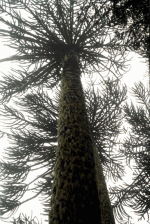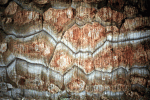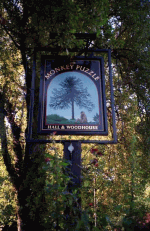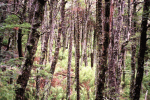Jul 2003, Vol. 7 No. 10
 Danger is a fitting word for what I found on a foggy Sunday morning in southern Chile when I first stepped into the woods. It was a hike like none I have ever taken. Monkey puzzle trees towered above thin, straight branches forming a grid in the sky. At ground level, snakelike limbs from younger trees bobbed in front of me. A fog rolled across the landscape. Such drama was unexpected from a comic plant, a threatened species that looks like a Dr. Seuss creation.
Danger is a fitting word for what I found on a foggy Sunday morning in southern Chile when I first stepped into the woods. It was a hike like none I have ever taken. Monkey puzzle trees towered above thin, straight branches forming a grid in the sky. At ground level, snakelike limbs from younger trees bobbed in front of me. A fog rolled across the landscape. Such drama was unexpected from a comic plant, a threatened species that looks like a Dr. Seuss creation.
I was one of only three visitors that day to Nahuelbuta National Park, whose name means “Big Tiger” in the Mapuche Indian language. The name is inspired by the puma, seven of which are said to still live in the park. But there are no native monkeys here or anywhere else in Chile, the tree’s name is a Victorian fancy.
My guide, Zandra Neira and I were about halfway through a three-mile walk. It felt, and was, prehistoric. The monkey puzzle is one the oldest living tree species, one of the first to produce seeds. The forests are unchanged over millions of years, a real-life Jurassic Park. That’s what recently led the BBC to come Chile to film the forests for a series on the lives of dinosaurs.
As we hiked, I began to notice piles of manure in the path. At first they didn’t register as cause for concern: Horseback riding is common in Chile. But this forest was remote and we were alone on the trail.
Zandra and I stopped for a drink of water. There was silence. Then I heard a growl and a rustling in the brush behind me. I was sure I had imagined it. The look on my guide’s face said otherwise.
Zandra started sprinting.
 I followed, afraid to look back. If there had been time to reflect, I might have marveled at the long path that led me to be fleeing through a monkey puzzle forest.
I followed, afraid to look back. If there had been time to reflect, I might have marveled at the long path that led me to be fleeing through a monkey puzzle forest.
But none of this crossed my mind as I dashed through the forest.
I never learned what growled at us that morning. A ranger later said it probably had been a wild boar, an aggressive beast that can weigh hundreds of pounds but is rarely encountered by visitors. Less glamorous than a wildcat, or a dinosaur, perhaps, but still dangerous. And as far as frights go, Steven Spielberg couldn’t have done better.
Our sprint soon brought us to a granite dome. We scrambled up through fog toward a mountaintop platform that on a clear day promises sweeping views. That April day, well into South America’s autumn, we could barely see 50 yards. But what was lost in clarity was more than made up in atmosphere.
We were surrounded by monkey puzzles. As mist swirled, long tree trunks with their bushy crowns drifted in and out of view. We climbed higher, and it began to sleet. The trees faded to silhouettes on the horizon.
I thought about my conversation with a ranger that morning when we stopped to pay the park entrance fee. Segundo Oliva, the assistant manager and the only person on duty that day, invited us into his tiny office. He said the araucaria, as the monkey puzzle is known in South America, has a special place in the hearts of Chileans.
“Even people that don’t care very much about nature feel a very special way when they walk under the trees,” he said.
 The monkey puzzle tree has survived for a quarter-billion years. Dinosaurs dined on tasty branches, the tree’s ancestors witnessed continents drift and the emergence of homo sapiens. The primitive tree appears too fanciful to be a work of nature. Long, ropy branches growing symmetrically around its straight trunk divided at regular intervals. As a sapling, it resembles a cartoonish maze. The adult tree towers more than 150 feet spreading its branches like an umbrella.
The monkey puzzle tree has survived for a quarter-billion years. Dinosaurs dined on tasty branches, the tree’s ancestors witnessed continents drift and the emergence of homo sapiens. The primitive tree appears too fanciful to be a work of nature. Long, ropy branches growing symmetrically around its straight trunk divided at regular intervals. As a sapling, it resembles a cartoonish maze. The adult tree towers more than 150 feet spreading its branches like an umbrella.
Monkey puzzle conifers are limited to a tiny region of South America. When European explorers first discovered the plant, they took it home as a wonder of the New World. It delighted Victorians, attracting crowds to London’s Kew Gardens, sparking a 19th-century gardening craze.
Monkey puzzle forests may be the world’s most unusual. Even the U.S. Forest Service skips the jargon with its description of the tree: “bizarre.”
I became fascinated with the tree in 1990, when I first saw it in an arboretum in Vancouver, British Columbia. I was spending a year in the city and was so taken with its alien appearance that my newlywed wife and I even planted one in the back yard of our rental home.
In recent years, I’ve taken detours from trips to track down specimens in England and the Pacific Northwest. The trees, an oddity of nature, a freak plant with an amusing past, always made me smile.
 I couldn’t imagine what they would look like in the wild. Later I learned there weren’t many wild places to find them. Shrinking habitat now threatens the monkey puzzle, which grows in small pockets of the Chilean coastal mountains and in the Andes. It’s listed as endangered. The threat was underscored earlier this year when fires wiped out 17,000 acres of monkey puzzle forest, nearly 3 percent of Chile’s total.
I couldn’t imagine what they would look like in the wild. Later I learned there weren’t many wild places to find them. Shrinking habitat now threatens the monkey puzzle, which grows in small pockets of the Chilean coastal mountains and in the Andes. It’s listed as endangered. The threat was underscored earlier this year when fires wiped out 17,000 acres of monkey puzzle forest, nearly 3 percent of Chile’s total.
Then I asked him if there was a danger of losing the plant to extinction.
He looked down at his battered desk. He never answered.
The monkey puzzle tree once thrived across the planet. Petrified Forest National Park in Arizona is littered with the fossilized remains of the tree’s ancestor. There are also geologic specimens in Europe and Australia.
Such an odd tree has inspired many stories.
Spanish and Italian explorers first recorded it during the 1780s. But a Scot, Archibald Menzies, took the tree to England, and to fame. The scientist was sailing with Capt. George Vancouver. A popular story says he acquired the tree when Vancouver’s ship, HMS Discovery, stopped in Chile in 1795. The officers were welcomed at a state dinner with Chile’s colonial leader, who served an unfamiliar nut for dessert.
Menzies is said to have pocketed a handful of nuts from the dinner table, which he later germinated onboard the ship. One of the odd trees that emerged was presented to botanist Sir Joseph Banks, who gave it to the Royal Botanic Gardens, Kew. Among the tree’s devoted fans was King William IV, who called on it every time he visited the garden.
Most Chileans don’t know of the tree’s Victorian legacy. But in England, the tree created a stir, becoming a rare curiosity in the gardens of well-to-do gentlemen. And that’s how it got its colorful name.
 In 1834 a parliamentary lawyer attended a tree planting ceremony in Cornwall. He put his hand on the sapling and quipped that its forked branches whorled with spiky leaves would be a puzzle for a monkey climb. The off-hand jest quickly took root.
In 1834 a parliamentary lawyer attended a tree planting ceremony in Cornwall. He put his hand on the sapling and quipped that its forked branches whorled with spiky leaves would be a puzzle for a monkey climb. The off-hand jest quickly took root.
As seeds became available, monkey puzzles emerged as a fixture of the British countryside, adorning church grounds, estates and parks.
The tree later spread to Europe and North America. It can grow on the East Coast as far north as Long Island, N.Y. But it’s more prominent in the West, particularly in Oregon, Washington and British Columbia.
Still the wild tree has never quite adapted to an ornamental role. Just last month, officials at a museum in San Jose, Calif., had to cordon off their monkey puzzle with police tape. The tree was dropping its 20-pound cones, perfectly natural for the forest, but a potential disaster for pedestrians in the city
Chile’s other prime park for monkey puzzles is Conguillio. It’s in the northern edge of the Lake District, a miniature Alps in southern Chile, dotted with ski slopes and summer resorts.
Conguillio backs up to an active volcano. The area is home to a once-fierce group of Indians, never defeated by the Inca or Spanish. One of their tribes is the Pehuenche, literally the People of the Monkey Puzzle. They worshipped the plant and depended on it for medicine and food.
Its seeds, about 2 inches long, are available in grocery stores in season. Eaten raw or boiled, the seed is said to taste like a chestnut. It can also be pounded into flour or made into a potent alcoholic drink.
Coming from the north, the road to Conguillio National Park skirts well-tended dairy farms, then dips into a gray, rocky wasteland. The gravel road is scratched from lava fields, remnants of a 1930s eruption. The only vegetation is a few monkey puzzles, which thrive in volcanic soil.
 The road eventually dips into a pine forest. Soon it passes fetching lake views and swimming beaches. The park headquarters was chilly the day we visited, and the nature museum dark. A ranger happy to have company offered to show us around.
The road eventually dips into a pine forest. Soon it passes fetching lake views and swimming beaches. The park headquarters was chilly the day we visited, and the nature museum dark. A ranger happy to have company offered to show us around.
First she led us to cabins built around the trunks of monkey puzzles. The homes are reserved for park workers. She said she once slept there, bedding down in a loft next to the tree. All night long, it creaked in the wind.
We explored the area, crossing lava and discovering a mosaic of dried branches and cones that someone had carefully arranged on the ground. Art or altar? It wasn’t clear.
Before I left the forest I had one last goal: the madre araucaria, or mother monkey puzzle, found two miles into the forest.
The trail first crossed through thick Chilean bamboo, and then passed a grove of another rare tree, the southern beech. It was bearded with lime-gray lichen, giving a magical touch to the dark afternoon. It was another damp day and the forest smelled of musty pine.
We hiked for 45 minutes, chilled and clammy under our rain jackets. Finally we reached a semicircle of benches. They surrounded the madre, the park’s largest monkey puzzle, which towers 165 feet. It’s believed to be nearly 2,000 years old.
A ranger, Miguel Angel Miranda, told me that day why he had spent the last 12 years working in the forest. He said he often imagined what a tree that had lived for thousands of years might have witnessed: Indian wars, Spanish conquest, volcanic eruptions.
“The trees,” he said, “have many things to say.”
I looked up at the madre and listened.
If you go:
Two of the best places to see the monkey puzzle are Nahuelbuta and Conguillio national parks in southern Chile. The area’s high season is November through March. Late April was chilly and misty, but without crowds. The parks are within a few hours’ drive of Concepcion and Temuco, both lively regional cities with frequent air service to Santiago, Chile’s capital, which can be reached by nonstop service from Dallas-Fort Worth International Airport. Another possible base for Conguillio is Pucon, a resort town with access to hot springs and outdoor sports.
The national air carrier, LanChile, has a good safety and service record. Inexpensive Internet fares are available; I paid less than $100 round trip from Santiago. Visitors will need to drive or take a tour. Park roads are rough but passable. My trip was led by EnjoyTour in Pucon (011-56-45-442313; www.enjoytour.cl). It was coordinated by Sportstour in Santiago (011-56-2-549-5200; www.sportstour.cl).
I visited the two parks over three days, starting with an afternoon arrival in Concepcion. The next morning our tour group drove two hours to Nahuelbuta. (It’s also possible to fly to Los Angeles, Chile, which is closer to the park, but the city has less frequent air service.) That afternoon I headed to Temuco, several hours away on the Pan American Highway. Conguillio is about 90 minutes from Temuco.
Both parks have camping and limited services. Information: www.gochile.cl.
Other places to see the monkey puzzle are the privately run Cani Reserve, near Pucon, and Tolhuaca National Park and Malleco National Reserve. The latter two are remote and were hit by fires this year.
The Monkey Puzzle: An Endangered Species
The monkey puzzle is considered a “panda” tree, a striking life form that captures the public’s imagination and galvanizes support for conservation. Even so, it has had a bad year. Forest fires in January wiped out thousands of acres of monkey puzzles in three Chilean parks.
About 650,000 acres of the trees still exist in their native forest. Growth is limited to two spots: the coastal range of southern Chile, and the Argentine and Chilean sides of the Andes, near active volcanoes.
The tree is recognized as a threatened species by international treaty, and since 1990 it has been protected in Chile, sometimes zealously. A hotel in Pucon, Chile, recently designed its auditorium around a tree that stood in the construction site. Since the tree couldn’t legally be cut down, its trunk now passes through the middle of the hall and emerges through a hole in the roof.
Still, conservationists say that with 70 percent of Chile’s monkey puzzle forests in private hands, the tree’s future isn’t assured. Even now, there is occasional illegal logging, said David Tecklin, a regional coordinator for the World Wildlife Fund in Valdivia, Chile. Grazing livestock eat saplings. In addition, some nut harvesters damage trees by breaking branches to reach prized cones.
Scottish researchers are hoping Great Britain’s climate, friendly to the monkey puzzle, can help preserve the species. The Conifer Conservation Programme, affiliated with the Royal Botanic Garden in Edinburgh, is planting small groves of monkey puzzles with up to 500 trees. The goal is to preserve the tree’s genetic diversity if its home forests are ever lost, said Phillip Thomas, the project coordinator.
Environmentalists are also concerned about Chile’s other trees. The country has among the world’s largest concentration of temperate rain forests _ and a thriving logging industry. Activists say old-growth sites are being replaced with pine and eucalyptus plantations, and unique ecosystems are being destroyed. The government says the threat is overstated and that existing laws protect the forests.
